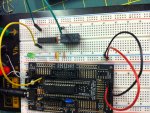Charles Jenkinson
New Member
Sorry to bother you wonderful people...
I have a Picaxe 28X-2 which I am trying to interface to a ULN2803APG Darlington Array. I want the output of the array to trigger a relay. To test the concept, I created a simple program to flash an LED. Your typical code:
Do
High B.1
Pause 1000
Low B.1
Pause 1000
Loop
The same code used so often. It is loading onto the Picaxe bootstrap, and will flash an LED if placed correctly, so I know it is not a problem with code.
The ULN2803APG is then placed as per the data sheet, with pin 9 connected to ground, and pin 10 connected to +5V.
I have used pin 2 and 17 as the input/output on the Darlington array.
Relay is wired correctly, and works. I can trip the relay by connecting the green wire shown in picture to positive. However, when connected to the Darlington array, nothing happens. The Darlington array will not flash the LED either. (In the position shown, the LED flashes on for a second, and off for a second, as expected. Nothing is changed by removing the LED.)

I have two of the 2803APG, as well as a ULN2003, none of which work.
Hopefully I have made an embarrassing newbie mistake - can anyone shed some light please?
Many thanks,
Charles
I have a Picaxe 28X-2 which I am trying to interface to a ULN2803APG Darlington Array. I want the output of the array to trigger a relay. To test the concept, I created a simple program to flash an LED. Your typical code:
Do
High B.1
Pause 1000
Low B.1
Pause 1000
Loop
The same code used so often. It is loading onto the Picaxe bootstrap, and will flash an LED if placed correctly, so I know it is not a problem with code.
The ULN2803APG is then placed as per the data sheet, with pin 9 connected to ground, and pin 10 connected to +5V.
I have used pin 2 and 17 as the input/output on the Darlington array.
Relay is wired correctly, and works. I can trip the relay by connecting the green wire shown in picture to positive. However, when connected to the Darlington array, nothing happens. The Darlington array will not flash the LED either. (In the position shown, the LED flashes on for a second, and off for a second, as expected. Nothing is changed by removing the LED.)

I have two of the 2803APG, as well as a ULN2003, none of which work.
Hopefully I have made an embarrassing newbie mistake - can anyone shed some light please?
Many thanks,
Charles
